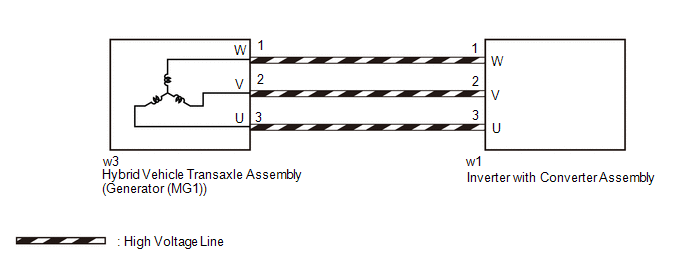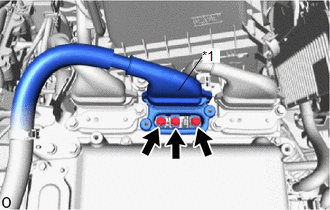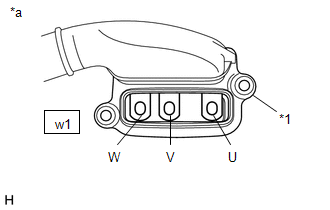Lexus NX: Generator High-voltage Circuit
DESCRIPTION
The cause of this malfunction may be the generator high-voltage circuit.
Check the generator internal resistance and the connection condition of the high-voltage line between the inverter and generator to check whether there is an open or short circuit.
Related Parts Check| Area | Inspection | Step |
|---|---|---|
| Generator cable connection check | Check for the connection condition of the cable from the inverter to the generator. | 1 |
| Generator or generator cable | Check the generator (including cable) internal resistance and the insulation resistance with body ground to check for an open or short circuit. | 2 |
WIRING DIAGRAM

CAUTION / NOTICE / HINT
This step is referenced from the procedures for each DTC.
If the inspection results below are normal, perform the next procedure for the referenced DTC.
CAUTION:
- Before inspecting the high-voltage system or disconnecting the low voltage connector of the inverter with converter assembly, take safety precautions such as wearing insulated gloves and removing the service plug grip to prevent electrical shocks. After removing the service plug grip, put it in your pocket to prevent other technicians from accidentally reconnecting it while you are working on the high-voltage system.
-
After removing the service plug grip, wait for at least 10 minutes before touching any of the high-voltage connectors or terminals. After waiting for 10 minutes, check the voltage at the terminals in the inspection point in the inverter with converter assembly. The voltage should be 0 V before beginning work.
Click here
.gif)
HINT:
Waiting for at least 10 minutes is required to discharge the high-voltage capacitor inside the inverter with converter assembly.
NOTICE:
After turning the power switch off, waiting time may be required before disconnecting the cable from the negative (-) auxiliary battery terminal. Therefore, make sure to read the disconnecting the cable from the negative (-) auxiliary battery terminal notices before proceeding with work.
Click here .gif)
.gif)
.gif)
PROCEDURE
| 1. | CHECK INVERTER WITH CONVERTER ASSEMBLY (GENERATOR CABLE CONNECTION CONDITION) |
CAUTION:
Be sure to wear insulated gloves.
(a) Check that the service plug grip is not installed.
NOTICE:
After removing the service plug grip, do not turn the power switch on (READY), unless instructed by the repair manual because this may cause a malfunction.
| (b) Remove the inverter cover UPR from the inverter with converter assembly. |
|
| (c) Check that the bolts for the generator cable are tightened to the specified torque, the generator cable is connected securely, and there are no contact problems. Specified Condition: T = 8.0 N*m (82 kgf*cm, 71 in.*lbf) NOTICE: Make sure that the tightening torque of the bolt is between 6.4 and 9.6 N*m (65 and 98 kgf*cm, 57 and 85 in.*lbf). |
|
(d) Disconnect the generator cable from the inverter with converter assembly.
(e) Check for arc marks at the terminals for the generator cable.
| Result | Proceed to | |
|---|---|---|
| The terminals are connected securely and there are no contact problems. | There are no arc marks. | A |
| The terminals are not connected securely and there is a contact problem. | There are arc marks. | B |
| The terminals are not connected securely and there is a contact problem. | There are no arc marks. | C |
| The terminals are connected securely and there are no contact problems. | There are arc marks. | B |
(f) Connect the generator cable to the inverter with converter assembly.
(g) Install the inverter cover UPR.
| B | .gif) | REPLACE MALFUNCTIONING PARTS |
| C | .gif) | CONNECT SECURELY |
|
| 2. | CHECK HYBRID VEHICLE TRANSAXLE ASSEMBLY (GENERATOR (MG1)) |
CAUTION:
Be sure to wear insulated gloves.
(a) Check that the service plug grip is not installed.
NOTICE:
After removing the service plug grip, do not turn the power switch on (READY), unless instructed by the repair manual because this may cause a malfunction.
| (b) Remove the inverter cover UPR from the inverter with converter assembly. |
|
| (c) Disconnect the generator cable from the inverter with converter assembly. |
|
| (d) Check the generator (MG1) for an interphase short using a milliohmmeter. (1) Using a milliohmmeter, measure the resistance according to the value(s) in the table below. HINT: If the generator (MG1) temperature is high, the resistance will vary greatly from the specification. Therefore, measure the resistance at least 8 hours after the vehicle is stopped. Standard Resistance:
HINT: To correct the variation of the measured resistance due to temperature, use the following formula to calculate the resistance at 20°C (68°F). R20 = Rt / {1 + 0.00393 X (T - 20)} The calculation is based on the following: R20: Resistance at 20°C (68°F) (mΩ) Rt: Measured resistance (mΩ) T: Temperature when the resistance is measured (°C (°F).) |
|
(e) When checking for a short circuit between generator phases without using a milliohmmeter.
NOTICE:
The generator generates current when wheels are rotated by hand. Before performing the inspection, wrap the generator cable terminals with tape (non-residue type) or equivalent.
HINT:
A short circuit between the generator phases can be checked simply without using a milliohmmeter.
(1) Connect the cable to the negative (-) auxiliary battery terminal.
(2) Turn the power switch on (IG).
NOTICE:
Turning the power switch on (IG) with the service plug grip removed causes other DTCs to be stored. Clear the DTCs after performing this inspection.
(3) Move the shift lever to N.
(4) Lift up the vehicle.
(5) Rotate the front wheels in the same direction simultaneously by hand.
Standard:
Left and right wheels rotate smoothly (No short circuit between phases)
HINT:
If a short circuit exists between the generator phases, the front wheels do not rotate smoothly (some resistance is felt).
(6) Lower the vehicle.
(7) Move the shift lever to P.
(8) Turn the power switch off.
(9) Disconnect the cable from the negative (-) auxiliary battery terminal.
(f) Using a megohmmeter set to 500 V, measure the resistance according to the value(s) in the table below.
NOTICE:
Be sure to set the megohmmeter to 500 V when performing this test. Using a setting higher than 500 V can result in damage to the component being inspected.
Standard Resistance:
| Tester Connection | Condition | Specified Condition |
|---|---|---|
| w1-1 (W) - Body ground and shield ground | Power switch off | 100 MΩ or higher |
| w1-2 (V) - Body ground and shield ground | Power switch off | 100 MΩ or higher |
| w1-3 (U) - Body ground and shield ground | Power switch off | 100 MΩ or higher |
(g) Measure the resistance according to the value(s) in the table below.
HINT:
Perform this procedure only when checking for a short circuit between generator phases without using a milliohmmeter.
Standard Resistance:
| Tester Connection | Condition | Specified Condition |
|---|---|---|
| w1-1 (W) - w1-2 (V) | Power switch off | Below 1 Ω |
| w1-2 (V) - w1-3 (U) | Power switch off | Below 1 Ω |
(h) Reconnect the generator cable.
(i) Install the inverter cover UPR.
| OK | .gif) | GENERATOR HIGH-VOLTAGE CIRCUIT NORMAL (PERFORM NEXT STEP FOR REFERENCED DTC) |
| NG | .gif) | REPLACE HYBRID VEHICLE TRANSAXLE ASSEMBLY |

.png)

.gif)

